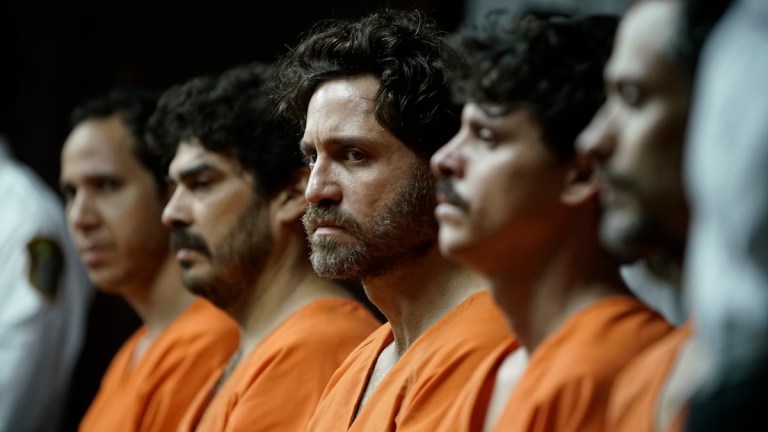The Real Story of Netflix’s Wasp Network – Who Were the Cuban Five?
Wasp Network tells the story of a group of Cuban intelligence officers known as the Cuban Five, but who were they and how does the film differ from real life?

Wasp Network, written and directed by Olivier Assayas based on the book The Last Soldiers of the Cold War by Fernando Morais, has landed on Netflix. It stars Penélope Cruz, Edgar Ramírez, Gael García Bernal and Ana de Armas and is based on the true story of the ‘Cuban Five’ (aka Miami Five) who were arrested and imprisoned in the USA as spies in the late ‘90s. The five were Gerardo Hernández, Antonio Guerrero, Ramón Labañino, Fernando González, and René González, though Wasp Network focuses attention primarily on René González and Gerardo Hernández of the five.
They were Cubans who travelled from Cuba under Fidel Castro’s regime, to Florida and became part of a group called the Wasp Network (La Red Avispa) who infiltrated anti-Castro Cuban exile groups based in Miami so they could feed information back to the Cuban government. Hernández (played by Gael Garcia Bernal in Wasp Network) assumed the identity of Puerto Rican Manuel Viramontez and was sent over to lead La Red Avispa.
Some of these Cuban militia groups were organising terrorist attacks on Cuba, particularly focusing on tourist hotels in an attempt to destroy Cuba’s economy, as well as smuggling drugs to finance activity and smuggling weapons with a plan to assassinate Castro.
Though the Wasp Network claimed to have foiled many attacks, in 1997 several bombs were detonated in hotels in Havana. One in the Copacabana Hotel was the worst and killed an Italian businessman, injuring several others. The attacks were organised by militant exile and CIA agent Luis Posada Carriles (Tony Plana) and although he admitted to having masterminded the bombings, he was never charged.
One of the groups La Red Avispa infiltrated was called Brothers To The Rescue, a Cuban exile group whose stated main purpose was to help Cuban refugees escaping on rafts. Brothers To The Rescue was run by José Basulto (played by Leonardo Sbaraglia in Wasp Network), who recruited René González and Juan Pablo Roque (more on him later) as pilots. The group also distributed anti-Castro leaflets in Havana and was accused of plotting terrorist activities by Cuba.
In 1996 two Brothers To The Rescue planes were shot down by the Cuban government killing the four pilots who were US Citizens. After this incident the US government who had been covertly monitoring the Wasp Network began to crack down.
The Cuban Five were arrested in 1998 and when they were prosecuted on various charges including espionage, Hernández was also charged with conspiracy to murder, the logic being that the intelligence fed back to Cuba is what lead to the deaths of these men. Hernández however maintains that this isn’t even true. Hernández was sentenced to two life terms to be served consecutively, René González got 15 years, Guerrero and Labañino got life sentences and Fernando González got a 19 year sentence.
The scene where Juan Pablo Roque denounced Brothers To The Rescue on TV after he had unexpectedly returned to Havana happened in real life, too.
Who was Juan Pablo Roque?
He was a former Major in the Cuban air force who defected to Florida and became a pilot with Brothers To The Rescue. While in America he became an informant for the FBI and was also part of the Wasp Network. He married secretary Ana Margarita Martinez (Ana de Armas) but 11 months after their wedding he disappeared back to Havana without saying a word to her. She later sued the Cuban government and was awarded $27 million punitive damages but only collected $200,000.
What was the spy swap that saw the release of Gerardo Hernández?
In 2014 under Obama’s leadership it was agreed that three members of the Cuban Five – Gerardo Hernández, Antonio Guerrero and Ramón Labañino – would be released in exchange for the Cuban government releasing American citizen Alan Gross who was accused by Cuba of spying and imprisoned. The other two of the Cuban five had already been released – René González in 2011 and Fernando González earlier in 2014. The swap was very important for diplomatic relations between America and Cuba not least because in Cuba the Five are perceived as heroes who were not spying on America but only on militant Cuban exiles who were a terrorist threat to Cuba.
What happened to Olga Salanueva?
René’s wife Olga was deported after three months in prison. She reunited with her daughter and campaigned for the release of the Five. More recently, in Jan 2018, she was in the press for writing an open letter criticising the Cuban government for not choosing her husband René as a member of parliament when two of the Five were selected. Fernando González and Gerardo Hernández had been listed as candidates while René González, Ramón Labañino and Antonio Guerrero were not.
How about Gerardo Hernández’s wife?
In the movie Hernández’s wife Adriana Perez (Anel Perdomo) mentions wanting a child. It’s a nod to what happened in real life. While Hernández was still incarcerated, Perez was afraid her chances of having a child were running out. She made a personal plea to a US Senator visiting Cuba and in 2013 as a sort of humanitarian gesture, Hernández’s sperm was transported to Panama for a first attempt at artificial insemination. This didn’t take but a second attempt in 2014 was successful. This is how, in images of the two just after Hernández’s release Perez is visibly pregnant.
Who were the other three, of the Cuban Five?
Antonio Guerrero
Guerrero was born in Miami to Cuban parents but returned with them to Cuba when he was just a baby. He was a bright student who studied as an airfield construction engineer in the Ukraine and worked on the expansion of the Santiago de Cuba International Airport. Guerrero was assigned a mission to go to Miami for the Wasp Network. Guerrero got life plus ten years, later resentenced to 21 years and 10 months. He was released on December 17 2014. He writes poetry and has two kids.
Ramón Labañino
Labañino was born in Havana and was also a very bright student who studied economics at university and was a strong sportsman. He went to Miami to work for Red Avispa and was originally sentenced to life plus 18 years, which was adjusted to 30 years. He was also released in December 2014. He has three daughters.
Fernando González Llort
González Llort studied International Political Relations and after he graduated served in the Cuban Revolutionary Armed Forces in Angola. He moved to Miami in 1993 to join Red Avispa and when he was arrested was sentenced to 19 years, later adjusted to 17 years and 9 months. He was released on February 27 2014. After his release he became a member of Cuba’s parliament and still works as a politician and a diplomat.
Wasp Network is available to stream on Netflix now.
